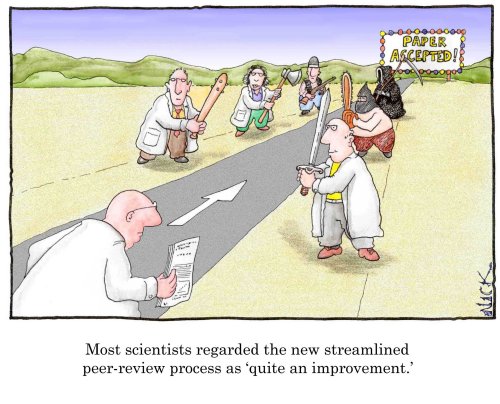Classic peer-review
The path to publishing a scientific paper has two major obstacles: first, the editor of a journal has to decide that a paper is potentially “interesting” enough for publication in their journal; if it passes that threshold, it is then sent out for “peer review” by two to four people chosen by the editor. The reviewers make a recommendation about whether or not the journal should publish the paper—if they all like it, chances are it will be accepted (potentially after additional experiments); if one of them hates it, chances are it will be rejected; if the reviews are mixed, the editor makes a judgment call. In total, this process involves a handful of people at most, and takes around a few months to a year (of course, if the paper is rejected, you generally start all over again).
Preacceptance peer review is costly (in terms of time and money), random (the correlation in perceived “publishability” of a paper between two groups of reviewers is little better than zero), ineffective at detecting errors, biased towards established groups and against originality, and sometimes abused (in that reviewers can steal ideas from papers they review or block the publication of competitors). Then, what is the alternative to preacceptance, secret peer review? the answer is quite obvious: postpublication open peer review.

Post publication open peer review
Open: Any scientist can instantly publish a peer review on any published paper. The scientist will submit the review to a public repository. Reviews can include written text, figures, and numerical quality ratings. The repository will link each paper to all its reviews, such that that readers are automatically presented with the evaluative meta-information. In addition, the repository allows anyone to rank papers according to a personal objective function computed on the basis of the public reviews and their numerical quality ratings. Peer review is open in both directions: (1) Any scientist can freely submit a review on any paper. (2) Anyone can freely access any review.
Post-publication: Reviews are submitted after publication, because the paper needs to be publicly accessible in order for any scientist to be able to review it. Post-publication reviews can add evaluative information to papers published in the current system (which have already been secretly reviewed before publication). For example, a highly controversial paper appearing in Science may motivate a number of supportive and critical post-publication reviews. The overall evaluation from these public reviews will affect the attention given to the paper by potential readers. The actual text of the reviews may help readers understand and judge the details of the paper.

With post publication peer-review authors overfly reviewers
How are we peer-reviewing articles?
We use two different methods for peer-reviewing articles once published. On one side, we allow comments of readers directly on the paper by using Google Doc Viewer. On the other side articles are submitted to LIBRE and Life Science Net for formal open peer review.

